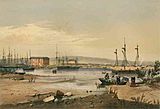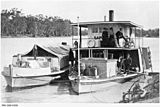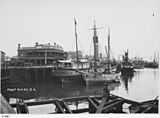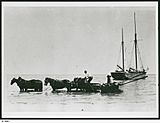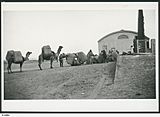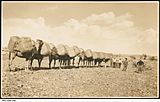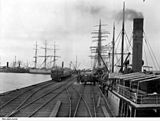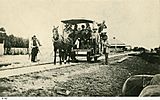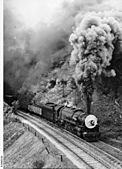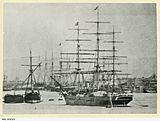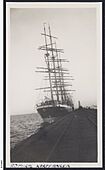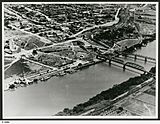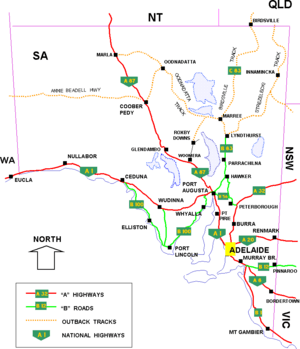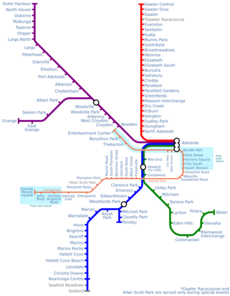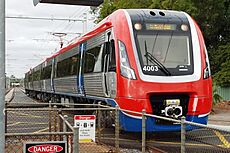Transport in South Australia facts for kids
South Australia uses a mix of ways to get around, including roads, trains, ships, and planes. The capital city, Adelaide, is the main hub for all transport in the state. About 1.4 million people live in Adelaide, which is most of South Australia's 1.7 million residents. Adelaide also has the state's biggest airport and seaport.
Road transport is the most common way people and goods move around South Australia. A huge network of roads connects all the towns, even the smaller ones. Most people use private cars to travel.
Adelaide is quite far from other big cities. For example, Melbourne is 800 km away. This makes air travel very important for getting to other cities quickly.
South Australia is also a key link for land transport between the eastern states of Australia, Western Australia, and the Northern Territory. The town of Port Augusta, located at the top of the Spencer Gulf, is the only railway link and one of only two sealed road links from the eastern states. Most large amounts of goods traveling by land pass through Port Augusta.
Contents
How Transport Changed Over Time
South Australia was first settled in 1836. Back then, there were no roads at all! Trade by sea used ships that carried goods in separate pieces. On land, people used horses and teams of bullocks (strong oxen). In the dry northern parts of the state, camel trains were a common way to move things. Horses, bullocks, and camels were used in remote areas until trucks became widely available after the Second World War.
A busy trade along the coast quickly grew. Goods from smaller ports were shipped to Adelaide. At first, ships were loaded right from the shore. Sometimes, a ship would be beached (pulled onto the sand) at high tide. Then, at low tide, carts could load goods directly onto it. The ship would then sail off on the next high tide.
Because South Australia doesn't have many natural harbors, and its gulf waters are calm, jetties became very important. These long structures reaching into the water are now a special feature of many South Australian towns and the Adelaide coastline. South Australia also played a big part in the clipper ship trade. These fast sailing ships collected large amounts of goods from coastal ports and carried them to Europe. South Australia was one of the last places where the clipper industry thrived, finally ending in the 1950s.
Coastal trade using sailing ketches (small sailing ships) continued until the early 1980s. The Nelcebee and the Falie were the last two ships involved in this trade.
As steam technology improved in the mid-1800s, steam trains and paddle steamers became very important for transport.
The first railway started in 1854. It connected Port Elliot to Goolwa, which was a major port on the Murray River steamer route. This first line was a horse-drawn tramway. A second railway was built in 1856, connecting Adelaide and Port Adelaide. The railway was later extended to Murray Bridge, also on the steamer route. A new bridge at Murray Bridge connected Adelaide to Melbourne by rail in 1886. The railway network quickly grew to cover much of the state.
Paddle steamers were great for moving large amounts of farm goods on the Murray River. They allowed access to inland areas and even into Victoria and New South Wales.
In the mid-1900s, new transport technologies appeared. Roads, road vehicles, and ways of handling cargo improved a lot. This led to more competition for the traditional railways and ports. Many smaller railways were closed down. Cargo at Port Adelaide was increasingly sent to the container port at Outer Harbour.
Today, much of South Australia's transport development focuses on roads. Ports are still important for large amounts of goods, but this is now done at only a few main ports. Rail transport is key for containerised goods and bulk transport between states. It also plays a smaller role in public transport within Adelaide.
- Historical Transport in South Australia
-
Rapid Bay, South Australia in 1950 with its limestone quarry and jetty for loading limestone onto ships
Road Transport in South Australia
South Australia has a very good road network. There are major highways connecting it to Western Australia, the Northern Territory, New South Wales, and Victoria.
Some of the main highways include:
- Augusta Highway and Princes Highway from Adelaide to Port Augusta
- Eyre Highway from Port Augusta to Perth
- Dukes Highway from Tailem Bend to Melbourne
- Stuart Highway from Port Augusta to Darwin
- Sturt Highway from Gawler to the Riverland
- South Eastern Freeway from Adelaide to Tailem Bend
The state also has many other roads that let you reach all its towns. The state government manages the major roads, while local councils look after the smaller ones. Roads in South Australia are generally in good condition. However, most roads in the northern part of the state are unpaved dirt tracks. These can often become impassable (impossible to use) after it rains.
Adelaide is unique because it doesn't have many freeways in the city center. The main part of the city, located on the flat land between the Adelaide Hills and the coast, has a grid of main roads with many intersections. On the edges of the city, there are several major freeways. These include the South Eastern Freeway, the Northern Expressway, Southern Expressway, the Port River Expressway, and the North-South Motorway.
Cars are the most popular way for people to travel to work or school in South Australia. While fewer people use public transport compared to cars, Adelaide has a large public bus network with frequent services. This network includes the 12 km O-Bahn Busway. This is a special guided busway that is one of the longest and fastest of its kind in the world.
Bus services are run by Adelaide Metro, which also manages the smaller train services. The bus network covers the entire metropolitan area. It stretches from Gawler in the north to Sellicks Beach in the south, a distance of over 90 km. Services also reach Mount Barker, Strathalbyn, and other smaller towns in the Adelaide Hills. Many larger towns also have their own public bus networks. Bus services between towns and states are provided by private companies like Stateliner, Firefly Express, and Greyhound Australia.
With its large road network, trucks play a huge role in South Australian transport. Very large trucks, like B-Doubles, are a common sight. Huge road trains are used in some areas of the state. Road trains up to 53 meters long are allowed on the Stuart Highway north of Port Augusta. Smaller road trains and B-Triples are allowed on many roads throughout the state north of Adelaide.
Rail Transport in South Australia
South Australia has standard gauge rail connections to all other mainland states. You can travel by train to Perth, Darwin, Broken Hill, and Melbourne. The state's railway network also has several branch lines. Many of these are used to carry minerals from the state's mines. There is also a separate narrow gauge railway operating on the Eyre Peninsula. This line runs from Port Lincoln to Ceduna.
Commuter trains run in Adelaide on a broad gauge network. It has five lines with 81 stations, covering a total of 125.9 km. The railway network is currently being changed from diesel trains to electric trains. The Seaford line was the first electric line to open in February 2014. Adelaide also has one tram line that goes to Glenelg from the city center. The tram line also extends to the Adelaide Entertainment Centre on the northwestern edge of Adelaide's Parklands.
The state has two historical tourist railways. The SteamRanger historical railway society runs various steam and other locomotives on the Victor Harbor line. This line runs between Mount Barker and Victor Harbor. Their services include regular Cockle Train rides between Goolwa and Victor Harbor. The Pichi Richi Railway operates on a 39 km section of the old narrow gauge Central Australia Railway. This line runs between Port Augusta and Quorn.
Air Transport in South Australia
South Australia has one major airport, which is located in Adelaide. Adelaide Airport offers many daily flights to the other capital cities in Australia. Airlines like Jetstar, Qantas, Tiger Airways, and Virgin Australia operate these flights. There are also frequent services to major towns within South Australia. These include Port Lincoln, Whyalla, Kingscote, and Mount Gambier. Flights also operate often to mining towns like Roxby Downs and Olympic Dam. These flights carry many fly-in fly-out workers.
Adelaide Airport also offers daily international flights to major Asian hubs. These include Singapore, Guangzhou, Dubai, Doha, Kuala Lumpur–International, and Denpasar. Auckland in New Zealand and Nadi in Fiji are also serviced by daily flights from Adelaide Airport.
Air freight (transporting goods by air) is limited in South Australia. There are only a small number of regular, major freight services. Some smaller air freight services within the state are provided by smaller jets and turboprop aircraft. These are especially important for reaching remote areas of the state.
Sea Transport in South Australia
South Australia has a major port at Port Adelaide. There are also many smaller ports along its coastline that handle materials like grain and minerals.
- Port Adelaide is the state's main seaport. It has a container terminal and a passenger terminal located at Outer Harbor. There are also several dock facilities in the inner harbor.
- Port Bonython is a facility that can handle large ships (panamax size). It handles petroleum products. Plans have been made to add facilities for ore at this port.
- Port Giles is a panamax-sized port facility used for handling grains. It is South Australia's newest port, built in 1970.
- Port Lincoln is an important port for South Australia's tuna fishing industry. It also handles large amounts of goods like grain and minerals.
- Thevenard, near Ceduna, handles gypsum, grains, salt, and mineral sands.
- Wallaroo handles grains and fertilisers.
- Whyalla has a port that can handle very large ships (panamax plus size). It handles grain and minerals.
The state has one major ferry service that travels to Kangaroo Island. This service runs between Cape Jervis and Pennashaw. This service is operated by Kangaroo Island SeaLink using two ferries: Sealion 2000 and the Spirit of Kangaroo Island. Most of Kangaroo Island's trade and visitors travel along this route.


